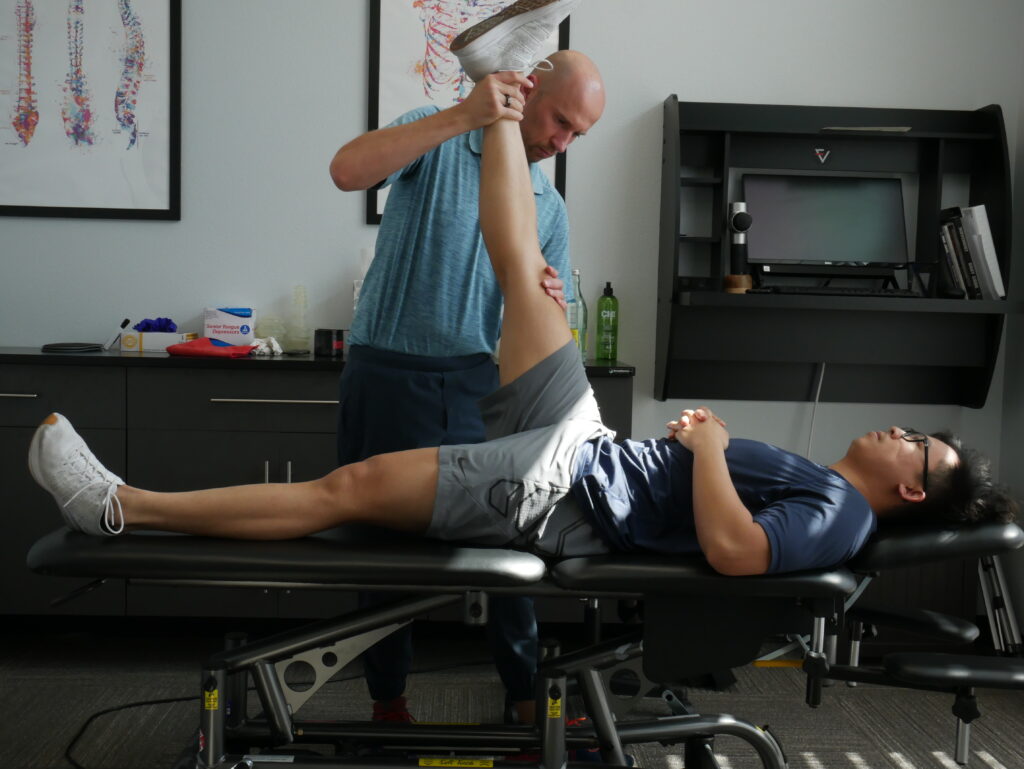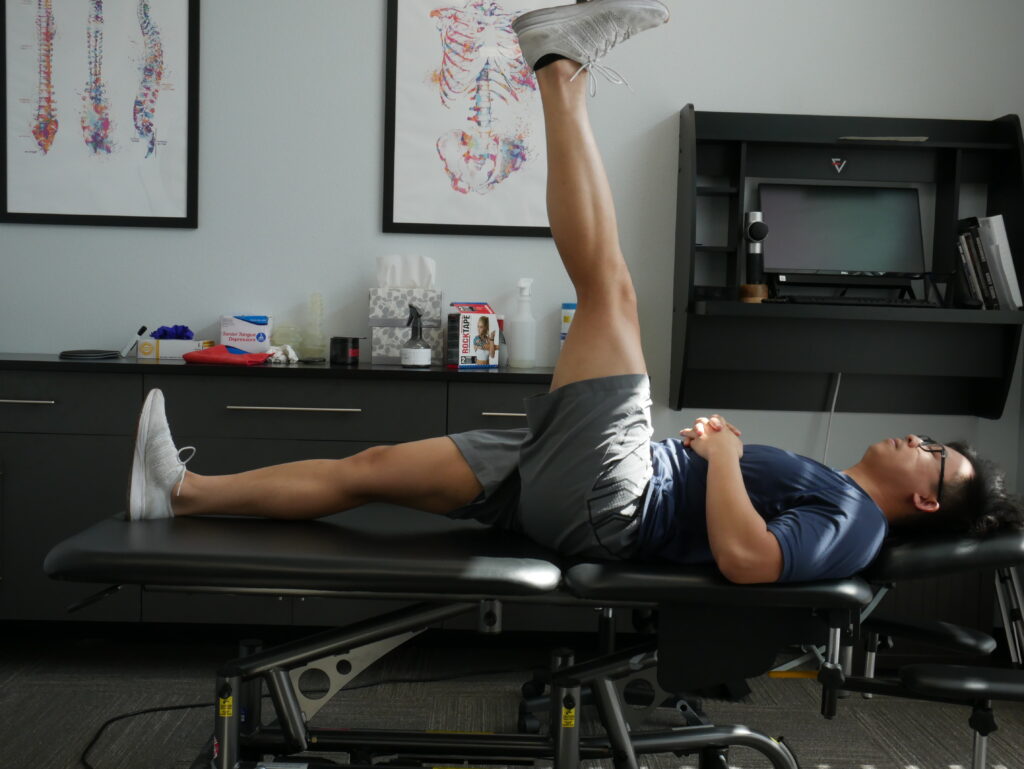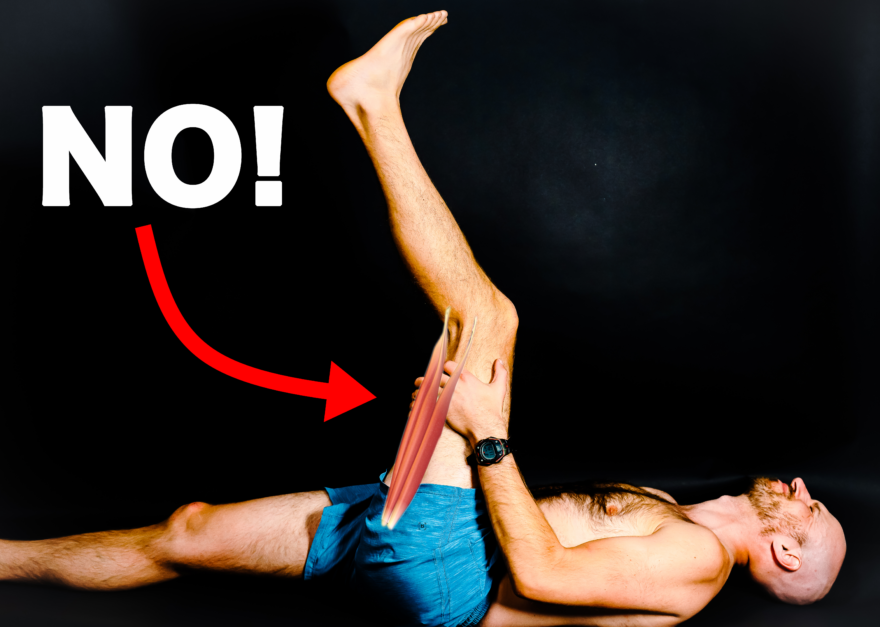Table of Contents
A better solution for tight hamstrings
If you often feel that your hamstrings are tight, your first thought might be to stretch them more. But what if you’re someone who can easily touch the floor with your palms? Or maybe you are SUPER stiff and stretching just doesn’t work.
Stretching may not be the solution. Especially when all that does is improve stretch tolerance.
So what is?
We’ll explore that in this post. You’ll learn why hamstring stretching may not work for everyone. Best yet, I’ll provide alternative strategies to relieve tension and improve flexibility.
Read, watch, listen, and learn below!
Hamstring length
To understand how to improve hamstring tightness, we need to consider how the knee and hip move.
The hamstrings are at their longest with knee extension and hip flexion. You can test this with a straight leg raise (SLR).

A “normal” SLR ranges from 70-90º. But now here’s the kicker.
One can experience tension at any point in the range. There are some people who could have a CRAZY SLR, but still feel tight.
Why is that?
Muscles always have some tension, even at rest. Otherwise, we’d fall over. Tension, or muscle activity, can be elevated at ANY point of muscle length. You can feel this in your bicep if you straighten your elbow and extend your arm. Your bicep will feel tight, but should you stretch it? It’s already at end range!
The same goes for your hamstrings. Excessive stretching can actually make the tension worse. This is because muscles contract against a stretch-based force. It’s Newton’s law in full effect.
Reduce hamstring tension by improving biomechanics
Instead of just stretching, we should focus on restoring movement options. Doing so will reduce the need for increased muscle activity in the hamstrings. More options means the forces we deal with can become more broadly distributed. Your hamstrings won’t have to work so hard!
How can we do this? By improving hip flexion mechanics!
Assessing your straight leg raise
The active straight leg raise (ASLR) can give you an idea of where your issue is at in the range.

Here’s how to do it:
- Lie on your back with your palms facing up.
- Keep your knees straight, but don’t squeeze your thigh muscles super hard
- Slowly lift one leg until you feel a tug on the hamstring or notice the opposite leg bending upward.
- Estimate the angle to see how high you can raise your leg.
- “Normal” is 70º-90º
Your findings can help you choose an appropriate exercise to improve your movement. This can help relieve tension.
Active straight leg raise less than 45º
When the ASLR is this limited, the goal will be to expand the posterior lower pelvis.
This expansion can occur by driving hip internal rotation. The key is to do it at a more externally rotated position, as this lessens the range of motion demands.
For that, I like the Thirsty Desert Pose:
- Place a couple of pads or pillows under your stomach.
- One side knee is slightly out, resting on the medial aspect
- Same side forearm at the side, creating a slight trunk side bent
- Reach forward with the opposite arm and look at your hand.
- Breathe in through your nose SILENTLY
- Exhale slowly through the mouth
- As you exhale, get HEAVY on the side bent side inner elbow and knee. 3/10 effort of weight. This will cause your chest to come up
- Keep weight on the lower ribs on the pads
- Perform for 5 sets x 5 breaths per side, 2 times per day for 2-4 weeks.
Active straight leg raise between 45º-60º
Here, the posterior pelvis still needs some expanding, but we can do so at a larger range. You’ll also want to drive some anterior lower pelvis expansion too.
Both of these needs can be met with a hingier squat. I like the walking wall squat:
- Stand a couple of feet away from a wall.
- Place a ball or yoga block between your knees.
- Soften your knees and look directly at the wall.
- Breathe in through your nose SILENTLY
- Exhale slowly through the mouth
- On the first exhale, walk down the wall as if you had suction cups on your hands. Your hips should hinge back WITHOUT moving the knees
- On the next breath, squat down. Act like you are going to sit in a chair.
- Keep pressure on the wall throughout
- Perform 5 sets x 5 breaths, 2 times per day for 2-4 weeks
Active straight leg raise less than greater than 60º
If you have a “good” ASLR, then you may actually need to (gasp) reduce the SLR, creating a more concentric position. This can occur by creating a more concentric position in the posterior lower pelvis. Doing so will expand the posterior upper pelvis.
For this, I like the adducted hooklying breathing:
- Place a miniband just above your knees
- Lie on your back with your feet and knees together.
- Position your hands just below your belly button.
- Put weight on the inner heel and big toe base on both feet.
- The feet should stay flat. NO TIPPING
- Keeping this foot heaviness, gently push the band out without losing foot contact. Your glutes will engage
- Breathe in through your nose SILENTLY
- Exhale slowly through the mouth
- Perform 5 sets x 5 breaths, 2 times per day for 2-4 weeks
Sum up
Hamstring tightness can be a common issue. Stretching alone might not provide the desired relief.
By understanding the biomechanics behind tight hamstrings, you can choose better moves. Exercises that will actually fix the true issue.
To recap:
- Hamstring tightness doesn’t always correlate with muscle length.
- Excessive stretching can lead to a rebound effect and worsen tension.
- Restoring optimal biomechanics is crucial for reducing hamstring tension.
- Assess your straight leg raise to determine the appropriate exercises.
If you want a similar thing for tight calves, you can check out this post here.
